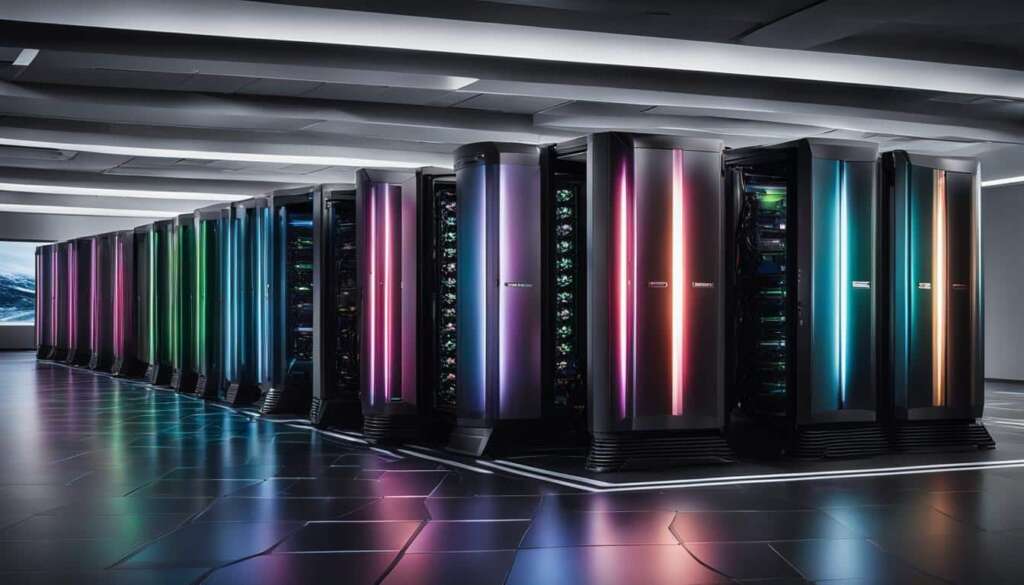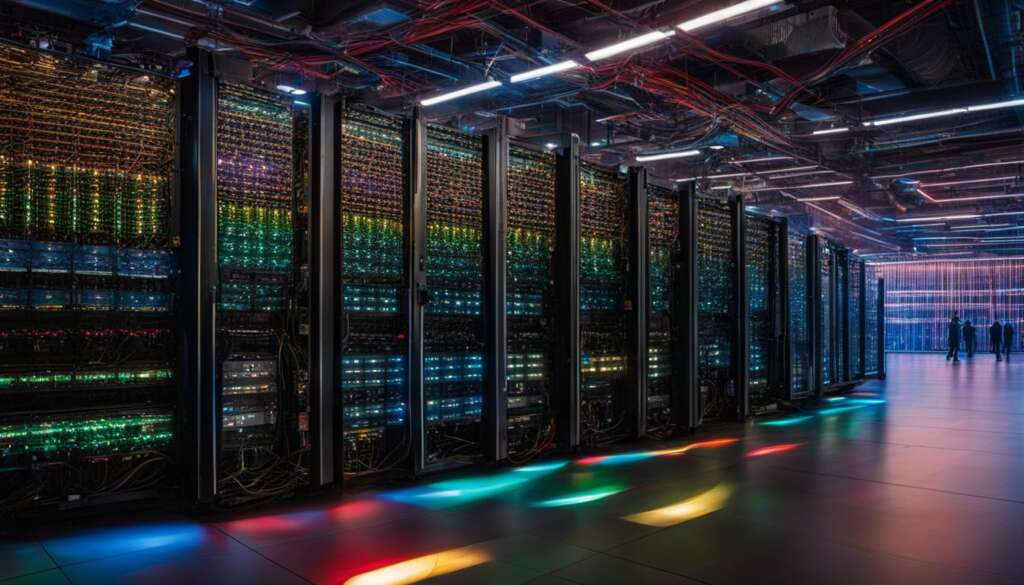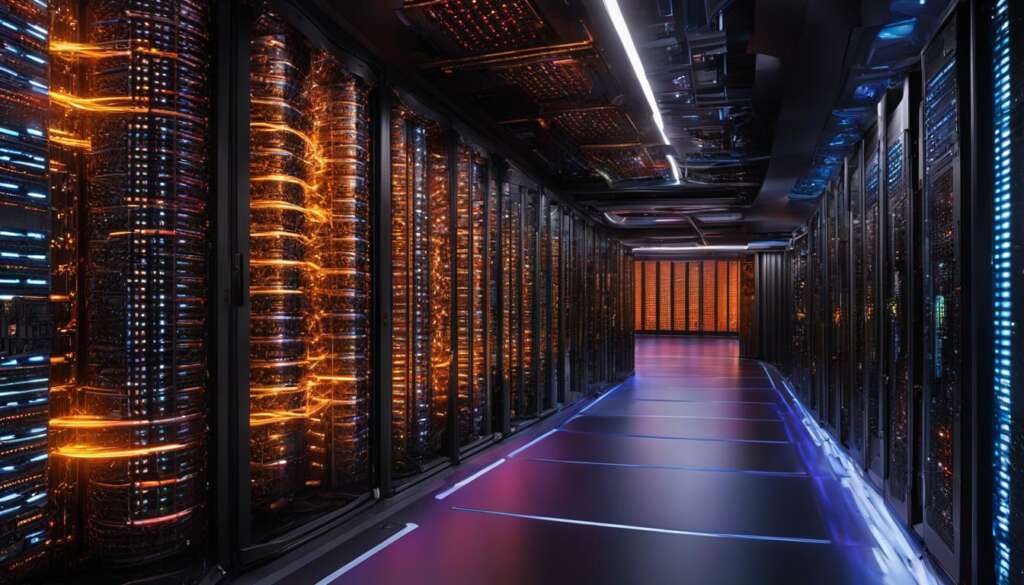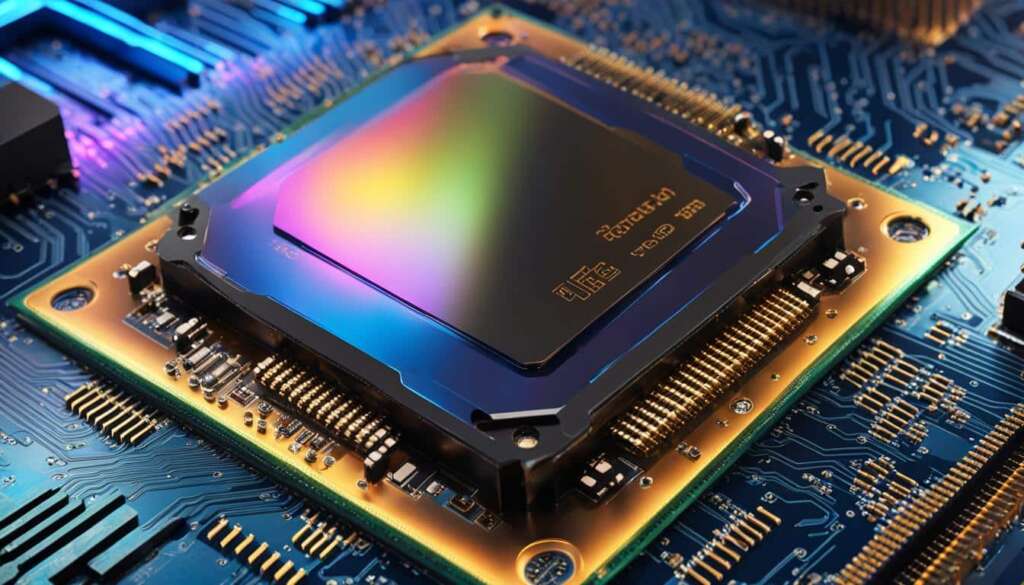Table of Contents
A supercomputer is a high-performance mainframe computer that excels at processing massive sets of data and complex calculations at rapid speeds. It stands out for its ability to interconnect multiple processors within one system, enabling parallel processing. Supercomputers are employed in various fields, including scientific research, data analysis, complex simulations, and artificial intelligence.
In scientific research, supercomputers play a pivotal role in advancing knowledge and innovation. They enable scientists to analyze vast amounts of data, model complex systems, and simulate intricate phenomena. The computational power and parallel processing capabilities of supercomputers make them essential tools for tackling complex challenges and pushing the boundaries of scientific discovery.
Key Takeaways:
- Supercomputers are high-performance mainframe computers that excel at processing massive amounts of data.
- They utilize parallel processing, interconnecting multiple processors to speed up calculations.
- Supercomputers are vital tools in scientific research, data analysis, complex simulations, and artificial intelligence.
- They play a crucial role in advancing knowledge and innovation in various fields.
- The future of supercomputers lies in achieving exascale computing and further advancements in artificial intelligence.
Supercomputer Definition & Architecture
Supercomputers are high-performing mainframe systems that are specifically designed to solve complex computations. They utilize multiple CPUs, or processors, which allow them to split tasks into multiple parts and work on them in parallel, accelerating the overall processing speed. With their large storage capacity, supercomputers can handle massive datasets and perform calculations that would take regular computers weeks or even months to complete.
The architecture of supercomputers is meticulously designed to maximize computational power and efficiency. These machines are built as mainframe computers, which are large-scale computing systems capable of processing vast amounts of information. Supercomputers are equipped with inter-node channels that enable communication between different nodes or processors within the system.
Supercomputers also interact with I/O systems, which refer to the input/output mechanisms responsible for handling disk storage and networking. This integration allows supercomputers to efficiently retrieve data from storage devices and communicate with other systems, enabling seamless data access and transfer.
In essence, the architecture of supercomputers combines the power of multiple processors and high-speed interconnectivity to achieve exceptional computational performance. Their ability to process tasks in parallel sets them apart from conventional computers, granting supercomputers the capacity to crunch through extensive calculations required for scientific research, data analysis, and complex simulations.
How Supercomputers Work
Supercomputers are capable of performing highly complex tasks at incredible speeds, thanks to their unique architecture and parallel processing capabilities. Let’s explore how these powerful machines work.
Parallel Processing
One of the key features of supercomputers is parallel processing. This technique involves breaking down large computational tasks into smaller subtasks that can be processed simultaneously by multiple central processing units (CPUs). By dividing the workload, supercomputers can solve problems much more efficiently, greatly reducing the time required for calculations.
Nodes and Interconnects
Supercomputers consist of numerous computing nodes, each equipped with its own CPU. These nodes are interconnected, allowing for efficient communication and data transfer between them. This network of interconnects ensures that the CPUs can collaborate effectively to solve complex problems in parallel.
I/O Systems
In addition to processing power, supercomputers rely on I/O systems for input/output operations. These systems handle interactions with external devices, such as disk storage and networking. They ensure that data can be stored and retrieved efficiently, enabling seamless integration with other computing resources or data sources.
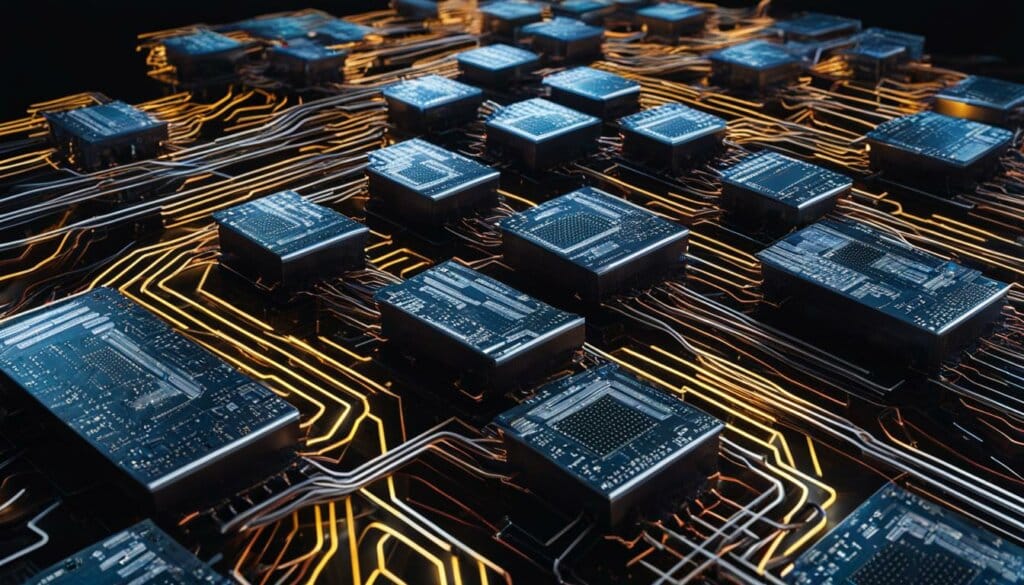
Unlike regular computers that solve one task at a time, supercomputers can perform multiple operations simultaneously, harnessing the power of parallel processing, interconnects, and I/O systems for high-speed computation and efficient processing of large datasets.
By combining parallel processing, interconnects, and I/O systems, supercomputers achieve remarkable computational power, enabling advanced scientific research, complex simulations, and data analysis. These machines continue to push the boundaries of what is possible in fields such as weather forecasting, genomics, aerospace, and energy research.
| Aspect | Description |
|---|---|
| Parallel Processing | Breaks down tasks into smaller subtasks, processed simultaneously by multiple CPUs. |
| Nodes and Interconnects | Multiple computing nodes interconnected to facilitate efficient collaboration. |
| I/O Systems | Handle input/output operations and enable seamless integration with external devices. |
In the next section, we explore the wide range of applications for supercomputers, highlighting their indispensable role in scientific research, weather forecasting, genomic sequencing, aviation engineering, space exploration, and nuclear fusion research.
Applications of Supercomputers
Supercomputers have various applications in scientific research and engineering. They are utilized in diverse fields to tackle complex problems and accelerate discoveries. Here are some key areas where supercomputers play a pivotal role:
1. Weather Forecasting
Supercomputers are integral to accurate weather forecasting. By analyzing massive amounts of meteorological data and running complex simulations, these machines help predict and understand weather patterns, severe storms, and the impact of climate change. Supercomputers enable meteorologists to provide more reliable forecasts, aiding in disaster preparedness and resource allocation.
2. Genomic Sequencing
In genomics, supercomputers revolutionize DNA sequencing. They process vast amounts of genetic data, enabling faster analysis of genomes and facilitating breakthroughs in personalized medicine and disease research. The computational power of supercomputers aids in identifying genetic variations, predicting disease risks, and developing targeted therapies.
3. Aviation Engineering
Supercomputers contribute to enhancing aircraft safety and performance. By simulating flight conditions, these machines help in detecting solar flares that can affect communication systems, predicting turbulence for efficient flight planning, and optimizing aerodynamic designs. Supercomputers ensure safer and more efficient air travel by supporting ongoing advancements in aviation technology.
4. Space Exploration
Supercomputers are essential tools in space exploration. Scientists and engineers utilize these machines to simulate space conditions, model spacecraft trajectories, and test mission plans. Supercomputers help in the exploration of distant planets, study cosmic phenomena, and aid in the development of innovative technologies for future space missions.
5. Nuclear Fusion Research
Supercomputers play a critical role in advancing nuclear fusion research. They simulate plasma behavior, optimize fusion reaction parameters, and explore designs for fusion reactors. By providing insights into energy production and containment, supercomputers contribute to the development of sustainable and clean energy sources.
These are just a few examples of the diverse applications of supercomputers. The immense computational power and high-speed processing capabilities enable researchers and engineers to tackle complex problems, generate valuable insights, and drive innovation forward.
| Application | Key Contributions |
|---|---|
| Weather Forecasting | Predicting and analyzing atmospheric conditions, improving accuracy of weather forecasts |
| Genomic Sequencing | Accelerating DNA analysis, aiding in disease diagnosis and treatment development |
| Aviation Engineering | Detecting solar flares, predicting turbulence, optimizing aircraft design |
| Space Exploration | Simulating outer space conditions, aiding in mission planning and spacecraft design |
| Nuclear Fusion Research | Optimizing performance in plasma, advancing clean energy technologies |
Speed and Performance of Supercomputers
When it comes to supercomputers, speed and performance are the name of the game. These powerful machines are designed to handle massive amounts of data and perform complex calculations at lightning-fast speeds. But just how fast are supercomputers? Let’s dive into the world of supercomputer speed and performance.
Supercomputers’ speed and performance are typically measured in FLOPS, or floating-point operations per second. This metric indicates the number of arithmetic problems a supercomputer can solve in a given timeframe. Supercomputers are known for their incredible computing power, with the fastest machines, such as Frontier, Fugaku, and Lumi, reaching speeds of quintillions of calculations per second.
To put the speed and performance of supercomputers into perspective, consider this: regular computers would take hundreds of years to complete the same computations that a supercomputer can handle in mere seconds. This exceptional computing power allows supercomputers to tackle complex simulations, data analyses, and other high-throughput tasks with ease.
Leading supercomputers, such as Frontier, Fugaku, and Lumi, have achieved exascale computing, reaching sustained computational power in the exaFLOPS range. Exascale computing refers to the ability of a supercomputer to perform a billion billion (10^18) floating-point operations per second, marking a significant milestone in the world of high-performance computing.
With such incredible speed and performance, supercomputers are pushing the boundaries of what is possible in scientific research, weather forecasting, genomics, aviation engineering, space exploration, and other fields that require massive computational power. These machines are at the forefront of technological advancements, enabling researchers and scientists to tackle complex problems and make groundbreaking discoveries.
Supercomputers are undoubtedly the champions of speed and performance in the world of computing. Their ability to process vast amounts of data and perform complex calculations at astonishing speeds is truly awe-inspiring. As technology continues to advance, supercomputers will only become more powerful, opening up new possibilities and propelling us into a future where the limits of computation are constantly being pushed.
Supercomputers’ speed and performance are truly remarkable, allowing them to handle massive calculations and complex simulations with ease. The future of supercomputing is beyond exciting as we continue to see advancements in computing power and new applications in various fields. Stay tuned for our next section, where we will explore the notable supercomputers in history.
Notable Supercomputers in History
Seymour Cray, a renowned computer designer, played a significant role in the early development of supercomputers. His Cray-1, introduced in 1976, was one of the first successful supercomputers, employing vector processing. Cray went on to found Cray Research, designing a series of supercomputers that pushed the boundaries of speed and performance.
Other notable supercomputers include IBM Roadrunner, the first to exceed one petaFLOPS, and IBM Watson, famous for its cognitive computing capabilities and triumph on Jeopardy!
The Future of Supercomputers
The future of supercomputers holds immense potential with advancements in computing technology. One key focus is on achieving exascale processing capabilities, enabling supercomputers to perform computations in the exaFLOPS range. Exascale computing represents a significant milestone in computational power, allowing for even more complex simulations and data analysis.
One exciting area that exascale computing opens up is neuromorphic computing. This field aims to develop computer systems that mimic the structure and function of the human brain. Supercomputers with exascale processing capabilities can accurately model complex systems, advancing our understanding of neuroscience and artificial intelligence (AI) applications.
The integration of supercomputers and AI is another significant development in the future of computing. With their remarkable processing power, supercomputers provide the necessary infrastructure for AI algorithms and applications. From machine learning to natural language processing, AI algorithms can benefit from the parallel processing capabilities and high-speed computation offered by supercomputers, accelerating advancements in AI research and development.
The supercomputer market is expected to continue growing as the demand for high-performance computing (HPC) and AI technologies increases. Organizations across various industries, such as healthcare, finance, and energy, recognize the value of supercomputers in solving complex problems and gaining insights from large data sets. Increased investment in HPC and AI will drive further innovations and push the boundaries of what supercomputers can achieve.
As we look to the future, the convergence of exascale computing, neuromorphic computing, and AI presents exciting opportunities for scientific research, data analysis, and problem-solving. Supercomputers will continue to play a crucial role in advancing technology and enabling groundbreaking discoveries in various fields.
Conclusion
Supercomputers play a crucial role in advancing scientific research, enabling complex simulations, data analysis, and computational power beyond the capabilities of regular computers. These high-performance machines have revolutionized the way we approach scientific challenges and have opened up new frontiers in various fields.
From weather forecasting and genomic sequencing to aviation engineering and space exploration, supercomputers have become integral tools in pushing the boundaries of knowledge. Their immense computational power allows researchers to analyze vast amounts of data, model intricate systems, and solve complex problems that were once unimaginable.
Looking to the future, the trajectory of supercomputers is clear. The goal is to achieve exascale computing, where these machines can perform computations in the exaFLOPS range, further expanding their potential. Additionally, advancements in artificial intelligence (AI) and high-performance computing (HPC) will continue to drive innovation in the supercomputer industry, with applications in diverse areas such as healthcare, energy, and climate change.
As technology evolves, supercomputers will continue to redefine computational power and push the boundaries of what is possible in scientific discovery and problem-solving. The understanding and utilization of supercomputers in scientific research will continue to grow, laying the foundation for future trends that will shape our world.
FAQ
What is a supercomputer?
A supercomputer is a high-performance mainframe computer that is known for processing massive sets of data and complex calculations at rapid speeds. It is designed to interlink multiple processors within one system, enabling parallel processing.
What is parallel processing?
Parallel processing is a technique used by supercomputers where tasks are split into smaller parts and each part is sent to a CPU to solve. This allows supercomputers to perform multiple operations at once, which significantly increases computational speed and efficiency.
How do supercomputers work?
Supercomputers work by utilizing parallel processing, where tasks are divided into smaller parts and assigned to different CPUs. These CPUs are located within nodes and communicate through interconnects, enabling concurrent computation. Supercomputers also interact with I/O systems for disk storage and networking.
What are the applications of supercomputers?
Supercomputers are used in various fields, including scientific research, weather forecasting, genomic sequencing, aviation engineering, space exploration, and nuclear fusion research. They are instrumental in conducting complex simulations, data analysis, and advancing technological innovations.
How fast are supercomputers?
The speed and performance of supercomputers are measured in FLOPS (floating-point operations per second). The fastest supercomputers can perform quintillions of calculations per second. These high-performance machines can compute simulations at a speed that would take regular computers weeks or even months.
Can you provide examples of notable supercomputers?
Some notable supercomputers include the Cray-1, designed by Seymour Cray, which was one of the first successful supercomputers employing vector processing. Other notable examples include IBM Roadrunner, the first to exceed one petaFLOPS, and IBM Watson, famous for its cognitive computing capabilities.
What is the future of supercomputers?
The future of supercomputers is centered around achieving exascale processing capabilities, enabling computations in the exaFLOPS range. This opens up new possibilities in fields such as neuromorphic computing and artificial intelligence (AI). Supercomputers will continue to advance in performance and play a crucial role in scientific research and problem-solving.
What is the significance of supercomputers in scientific research?
Supercomputers are vital in scientific research as they enable complex simulations, data analysis, and computational power that surpasses the capabilities of regular computers. They contribute to advancements in various fields, from weather forecasting and genomic sequencing to aviation engineering and space exploration.
Source Links
- https://builtin.com/hardware/supercomputers
- https://www.britannica.com/technology/supercomputer
- https://www.techtarget.com/whatis/definition/supercomputer


